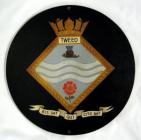1
The Royal Navy frigate HMS Tweed was completed on April 28, 1943, at Glasgow and after working up at Tobermory, she joined an RCN support group, EG 5 in June. From then until December she served with the group in support of North Atlantic convoys, operating from Londonderry and St. John's. On January 7, 1944, while on blockade-runner patrol northwest of Spain, she was torpedoed and sunk by U-305.2
Notes from a Surgeon Lieutenant regarding the H.M.S.TweedIn October or November, the great individual drama, Tweed rammed a U-boat. We followed it at night by radar, (it was on the surface), we were several miles astern, the submarine was on our port quarter although it was a dark night, we got to the stage where it was visible. The order "prepare to ram" was given over the Tannoy. The U-boat very late in the day blew main Veuts and we hit it, gunned it with our 4inch above the gunning tower and it appeared to roll over to port before depth charging. It appeared astern having been blown onto the surface by our pattern of depth charges, too shallow!
It disappeared astern and we continued hunting it. I ciphered up a signal to C. in C.W.A. "Have rammed and gunned and depth charged submarine in position"? It must have been nearer to Iceland then Newfoundland, our fore peak was opened to the sea and port bridge keel badly damaged. All this was probably for the last time, as an AFO came out soon after, warning escort vessels not to attempt ramming U-boats. After stemming the flow of water into fore peak, we returned to Derry. Over a fortnight under repair we were credited with "Probably damaged"1, but I believe this was the last time this order, the order, "Prepare to ram" was given and carried out. It was broadcast over the ship Tannoy system as I have already stated. We were out of action for nearly three weeks, no medals.
4
Notes from a Surgeon Lieutenant on the Sinking of the H.M.S.TweedOn January 7, 1944 H.M.S. Tweed in company with H.M.S. NENE and H.M.C.S. WASKESIU, was carrying out an A/S patrol in the region of 43N.21W. The ships were steaming in line abreast, two miles apart, Tweed being the Port ship; the weather was fine and sunny, sea calm, water temperature 60F air temperature 55F. At about 1615, the alarm bells sounded "A/S stations", approximately fifteen seconds later the ship was hit by a torpedo just above the after engine bulkhead. She lost way and started to sink by the stern with a list to starboard. Order to abandon ship was given immediately and not without justification as she sank completely in three minutes. No boat could be got away in the time and unfortunately only one of the three Carley floats. In spite of the suddeness of the whole incident, the mess decks seem to have been cleared completely and very few men went down with the ship, apart from those in the boiler rooms and after compartments. Two stokers swam out of the engine room skylight when it reached sea level. While we were swimming away from the ship and while the bow was yet sticking out of the water, one depth charge exploded---probably 250 feet--- this was responsible for all the casualties either directly of indirectly as everyone was in the water at the time; the furthest away could not have been more than 100 yards from the center of the explosion. The force of the explosion was considerable. And felt as though something had squeezed the chest and abdomen tightly and suddenly. The majority immediately began to cough up bright blood and become incontinent of urine and faeces. A number commenced to drown and some must have been killed instantly. The survivors soon became spread out over an area of 300 yards square, which was covered with a considerable amount of oil and wreckage. One group of about twenty was on and around the Carley float, another dozen or so were clinging to a large griping spar, ten or twelve pothers were making use of two Oropesa floats, the first lieutenant riding astride one and endeavoring to balance it. The rest were being supported by their life belts or odd pieces of wreckage.
Most men complained of crampy abdominal pains and diarrhea also haemoptysis and a few swallowed large quantities of oil.
After about two hours, H.M.S. NENE lowered her whaler towing two Carley floats -thirty-three survivors were picked up in half an hour or more just before dark; one was dead when rescued, two others died in the NENE a few hours later. About 15 were suffering badly from blast injuries, all the rest with one or two exceptions had malaena and/or haemoptysis and were in fairly exhausted condition for a day or so, being unable to eat solid food.
It appeared that fat or well covered men came off better that thinner ones, and those wearing life belts and swimming on their backs seem to have benefited, though it is difficult to assess the value of this without knowing their distances from the explosion.
